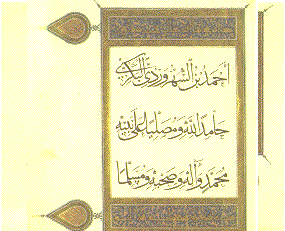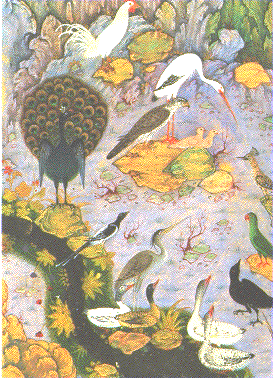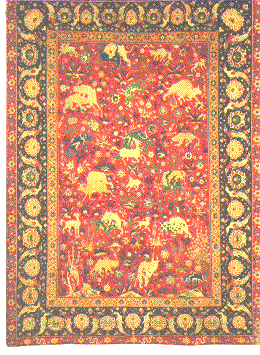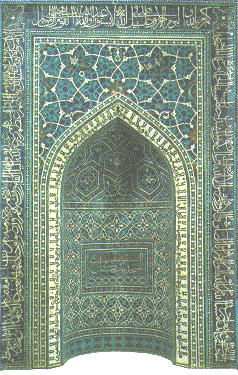|
Islamic art in the Metropolitan Museum of Art
by
Michael Burke
[[email protected]]
The MMA Collections
Where is Islamic art in New York? Well, one place is the Metropolitan
Museum of Art which devotes space to a large collection of Islamic
art objects.
- These objects come from an Islamic civilization which stretched
from Spain to India.
- They include several primary means of expression:-- calligraphy,
illumined manuscripts, metalwork, and sculpture among many other
forms.
Islamic Art in Context
Many of the objects in the MMA originate from contexts specific
to the variety if Islamic civilization.
- Some are portable because of the nomadic lifestyle of the
early Muslims and Arabs who were often on the go to hunt, and
fight and trade.
- Many objects are from gardens, which were cooler than buildings.
Islamic Art - Purposes and Styles
Islamic art is meticulously fabricated and designed. It had functional
and utilitarian purposes.
- Religion was an and is an important influence and patron behind
Islamic art and most Islamic art derives many motifs from the
Muslim religion.
- The most basic tendency of Islamic art is to cover the surfaces
of the objects with overall patterns. It often places the subject
with in a network of appealing and dense ornaments. Many of the
focal points of these ornaments include arabesques, inscriptions,
as well as pictures of trees, animals and flowers, or figures.
There is an infinity of variations on these themes:- such as the
concept of flowers in which each little stylized blossom symbolizes
the current state of culture and the evolving nature of the artist
craftsman. Another style is arabesque that employs never-ending
progressions of blossoms, stems and leaves that sometimes substitute
for angelic faces, or animal or dragon masks for flowers.
This web page examines the following types of Islamic Art in
the MMA collections.
Calligraphy
The supreme art for Muslims is calligraphy because they believe
this writing has a "sacramental" character since it
conveys the word of God (in the Qu'ran).
- One form is the Kufic script that employs shafts of
high letters which gradually and considerably became elongated
because of aesthetic considerations. This elongation was a natural
development because the Qu'ran in the central and eastern
Islamic world was no longer written on broad pages but rather
on the vertical book format.
- Other styles of Arabic script include the Maghribi style that partially blurred words, which are triangular and with
the letters very extended.
- The Nasta'lia style that describes a hanging script
so that some of the letters drop below the line.
- The Thuluth script found in various places such as
mosque walls, rugs, and on arms and armor.
The centers of calligraphy in the early Islamic age were Mecca,
Medina, Kufa, and Basrah. The Kufic script probably came from
Kufa but, in fact, there is no sufficient manuscript urvival to
distinguish the four branches of calligraphy by town. Thus, these
four branches are grouped together in the angular style in contradistinction
to the more curvilinear styles which are named individually. The
Metropolitan Museum of Art contains several examples of Qu'ranic
calligraphy

Illuminated Manuscripts
Another area of Islamic art, with obvious links to calligraphy,
is the category of illuminated manuscripts. The Metropolitan Museum
of Art collection includes manuscripts such as:
- A Funeral Procession
- Jonah and the Whale
- An Eavesdropper
- A Pair of Eagles
- The Portrait of a Sufi
An Example
 One leaf from
an illuminated manuscript called the Shahnama of Shah Tahmasp
was painted by the Sultan Muhammad in 1522 for the first Safavid
ruler of Iran, Sha' Isma'il (r. 1501-24) and his son Prince (later
Shah) Tahmasp (r. 1524-76). This leaf is one from one of the grandest
of royal copies of the Shahnama at Tabriz. The title of this leaf
is the Feast of Sadeh. The legend behind this leaf is that Shah
Hunshang, one of Iran's legendary rulers, sighted a hideous apparition,
threw a rock at it, but the rock missed and struck a boulder,
causing sparks. These sparks impressed Hushang who initiated fire
worship. One leaf from
an illuminated manuscript called the Shahnama of Shah Tahmasp
was painted by the Sultan Muhammad in 1522 for the first Safavid
ruler of Iran, Sha' Isma'il (r. 1501-24) and his son Prince (later
Shah) Tahmasp (r. 1524-76). This leaf is one from one of the grandest
of royal copies of the Shahnama at Tabriz. The title of this leaf
is the Feast of Sadeh. The legend behind this leaf is that Shah
Hunshang, one of Iran's legendary rulers, sighted a hideous apparition,
threw a rock at it, but the rock missed and struck a boulder,
causing sparks. These sparks impressed Hushang who initiated fire
worship.
He assembled his courtiers and their animals, discussed the
use of fire, and used fire for cooking to celebrate the feast
known as Sadeh. An allusion to this story is shown at the top
of the picture where a comical bear is hurling a rock at a snow
leopard.
This image is of the concourse of the birds.
Physical Objects
Another category of Islamic art consists of physical object -
this also is found in abundance in the Metropolitan Museum of
Art. Since Muslims view the creation of figures as sacrilege because
only God can create, (according to the Hadith - the "traditions"
of the Prophet), there are rarely any figural images at least
not in the mosques.
- Pottery: In the MMA, there are bowls, (one is an earthenware
bowl that is glazed and stain painted made in ninth century Iran).
Luster-painting was first employed in ninth century Iran with
the polychrome style being dominant in the ninth century and the
monochrome style being dominant in the tenth century. These bowls
often bear words in Kufic script. There are bowls from Nishapur,
Egypt, and Iran from the late twelfth century to the early thirteenth
century. There are also ewers from eleventh century Iran, Khorasan.
- Ceramics: Tiles from Syria in the twelfth century that
hold indecipherable Kufic script, luster-painted tiles used to
decorate mosques and tombs from Iran (Kashan) in the Khanid period
dated March 1308, and dishes all hold their place in the MMA also.
- Textiles: Woven items play an unique role in cultural
and social history. Textiles are one of the chief means of artistic
expression of a culture and the most influential vehicle for the
transmission of artistic ideas and styles. Texatiles move from
national boundaries due to social and political upheaval as well
as due to economic and diplomatic circumstances. Textiles were
and are a vital economic component of Islamic society. Tiraz cloth production was most important during the Abbasid and Fatimid
periods; and cloth production became the official responsibility
of a major government department. The issuing of Tiraz became
a royal prerogative; (the word tiraz is Persian for embroidery).
Tiraz inscriptions often included the ruler's name and title and
the date may be inscribed.
- Carpets: In the Metropolitan Museum of Art, there are
carpets from tenth century Yemen, and also from Spain, in the
Nasrid period of the fourteenth and fifteenth centuries. Ikatarchine
was the technique that formed the pattern before weaving by dying
and wrapping warp yarns methodically; this style created the Yemeni
textiles from the ninth to the fourteenth centuries. Other rugs
from the MMA include a prayer rug from Turkey in the Ottoman period
of the late sixteenth century , the Emperor's carpet from Iran
of the Safavid period, probably Herat in the mid-sixteenth century,
and a Polonaise carpet.
- Wall Hangings: There was a wall hanging technique called
the kalamkari, which consisted of woven cotton patterned
by pen with mordants and resist mediums in India, which is responsible
for a carpet from India in the Madras region, perhaps Pulicat
around 1640-50 and whose borders were made in the eighteenth century.
This carpet consists of cotton, mordants, resist mediums, and
dyes.

|
This is a picture is of one of the most famous Mamluk carpets which is called the "Simonetti " carpet from Egypt (Cairo) in the late fifteenth century or the early sixteenth century. This carpet, named after its owner, consists of wool pile and foundation, and is circa one hundred metrical knots per square inch. This carpet has five medallions instead of the more customary one or three and has a slightly brighter and more varied palette than is usual for its type. Mamluk carpets are surprisingly rich in appearance, considering the relatively coarse weave and limited color range. The overall effect of the carpet is that of a shimmering mosaic or colors. |
- Glassware: Other objects of that are of interest in
the Metropolitan Museum inlcude a Mamluk glass bottle from Syria
or Egypt (fourteenth century). It shows influence by China as
seen by a decoration of a phoenix (feng-huang) adorning the bottle.
- Objet's d'Art: There is an incense burner in a feline
form made by the Seljuks in the twelfth century that represents
a guardian. This burner is an example of the sophisticated later
stage of Seljuk art with its subtle variations and exquisitely
proportioned features.
Architectural Features
The decoration which is so much a part of Islamic art found expression
not only in documents and objects, but also on buildings. The
MMA collection documents this in a number of ways.
- The Damascus Room: This is really post-medieval. Created
in the eighteenth century, this was the room of Nur Ad-Din from
Syria. The room, complete with fountain, reveals the detailed
craftsmanship of Islamic architects, wood carvers, and ceramists.
 A Mihrab: A Mihrab is the niche in a mosque which points towards Mecca.
The MMA exaqmple has a composite body and is glazed and cut as
seen in the picture above. The decoration adorning it is executed
with great skill and devotion. Madrasa Imami in Isafahan around
1354 created this mihrab and composed it of a mosiac of small
glazed tiles fitted together to form various geometric and floral
patterns and inscriptions. There is an inscriptional frieze in muhaqqaq script, containing Sura IX: 14-22 from the Qu'ran that runs from bottom right to bottom left; an second inscription
in Kufic script, with some sayings of the Prophet, borders the
pointed arch of the script: and a third inscription, in cursive,
is set in a frame at the center of the niche. A Mihrab: A Mihrab is the niche in a mosque which points towards Mecca.
The MMA exaqmple has a composite body and is glazed and cut as
seen in the picture above. The decoration adorning it is executed
with great skill and devotion. Madrasa Imami in Isafahan around
1354 created this mihrab and composed it of a mosiac of small
glazed tiles fitted together to form various geometric and floral
patterns and inscriptions. There is an inscriptional frieze in muhaqqaq script, containing Sura IX: 14-22 from the Qu'ran that runs from bottom right to bottom left; an second inscription
in Kufic script, with some sayings of the Prophet, borders the
pointed arch of the script: and a third inscription, in cursive,
is set in a frame at the center of the niche. - The Dado Panel: This is a marble mosiac from Egypt
during the Mamluk period, in the first half of the fifteenth century.
The red, white, yellow, and black marble forms a mosaic pattern
based on five and ten pointed stars. This was the style of wall
decorations in the interior of mosques in the early fifteenth
century.
Islamic Art Links
Back to Medieval New York Page
This Page is part of the Medieval New York Web Project, a project of students in the Introduction to Medieval History courses taught by Paul Halsall in the History Department of Fordham University in
1996-1997.
© Copyright to the student creator of each page
The Internet History Sourcebooks Project is located at the History Department of Fordham University, New York. The Internet
Medieval Sourcebook, and other medieval components of the project, are located at
the Fordham University Center
for Medieval Studies.The IHSP recognizes the contribution of Fordham University, the
Fordham University History Department, and the Fordham Center for Medieval Studies in
providing web space and server support for the project. The IHSP is a project independent of Fordham University. Although the IHSP seeks to follow all applicable copyright law, Fordham University is not
the institutional owner, and is not liable as the result of any legal action.
© Site Concept and Design: Paul Halsall created 26 Jan 1996: latest revision 12 April 2024 [CV]
|